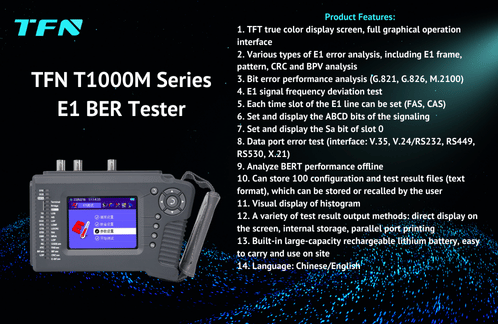What is a Bit Error Rate Tester (BERT)? The "Stethoscope" of Communication Network Quality
In modern communication systems, the accuracy and stability of signal transmission are crucial. A Bit Error Rate Tester (BERT) is a specialized instrument used to precisely measure the transmission quality of digital communication lines. Like a "stethoscope" for communication networks, it can quickly diagnose problems such as signal attenuation, clock skew, and interference, ensuring high-reliability transmission of voice, data, and other services.
1. Core Principles of a BERT
The operating principle of a BER tester is based on the "send-receive-compare" model:
1.1. Transmitter: Generates a specific test pattern, such as a pseudo-random code (e.g., 2E15-1, QRSS), all "1s," all "0s," or alternating codes, to simulate real-world service data flows.
1.2. Receiver: Captures the signal after it has passed through the line or device under test.
1.3. Comparison Analysis: Received data is compared bit by bit with the locally stored original transmission pattern, counting the number of error bits and calculating the core metric, the bit error rate (BER = number of error bits / total number of transmitted bits).
1.4. In-depth Analysis: Based on international standards such as ITU-T G.821, G.826, and M.2100, this analyzes more comprehensive performance parameters, such as errored seconds (ES), severely errored seconds (SES), and unavailable seconds (UAS), to assess the long-term stability of the line.
2. Key Functions of Modern BERTs (Taking the TFN T1000M as an Example)
Modern high-performance BERTs, such as the TFN T1000M, integrate a variety of powerful functions to meet the needs of complex scenarios:
2.1. Multi-Interface Support:
E1/G.703: Supports 75Ω (BNC) and 120Ω (RJ45) interfaces, enabling testing in various modes, including PCM30/PCM31 framing, unframing, and CRC4 checksums.
Data Interface: Fully compatible with common data interfaces such as V.35, V.24/RS232, RS449, RS530, and X.21, enabling bit error testing of Nx64Kbps high-speed data and low-speed synchronous/asynchronous data.
PING Test: Supports PPP ping on Ethernet IP, V.35, and E1 interfaces, verifying network connectivity and routing.
2.2. Comprehensive Test Modes:
Offline Test (Service Suspended): Performs in-depth performance evaluation during service interruption.
Online Testing (Service On): Monitors line quality in high-impedance bridge mode without interrupting existing services (e.g., the TFN T1000M's bridge mode impedance is >1000 ohms).
Live Test (Live Mode): Forwards received E1 data in real time while monitoring channel errors and alarms.
2.3. In-Depth Analysis Capabilities:
Alarm Detection: Monitors and displays key alarms such as Loss of Signal (LOS), Alarm Indication (AIS), Loss of Frame (LOF), and Remote Alarm (RAI) in real time.
Overhead Analysis: Sets, captures, and displays the Sa bit, Si bit, CAS signaling bits (ABCD), and MFAS (Multiframe Alignment Signal) in the E1 frame structure.
Frequency Offset Test: Accurately measures the deviation (in ppm) of the E1 line's actual clock frequency from the nominal value (2.048 MHz).
Round Delay Measurement: Quantifies the round-trip delay of a signal on the link.
2.4. Practical Auxiliary Functions:
Result Storage and Reporting: Supports storage of large numbers of configuration files and test results (e.g., 100 on the TFN T1000M), supports histogram display, and can export data to a PC via USB or output reports to a printer via the parallel port.
Automatic Testing: Preset start times allow for unattended, timed testing.
User-Programmable Patterns: Allows users to customize test patterns up to 32 characters long to meet specific testing needs.
3. Core Test Parameters
When using a bit error meter for testing, key parameters to monitor include:
3.1. Bit Error Rate (BER): The most critical metric, directly reflecting transmission reliability.
3.2. Errored Seconds (ES) & Severely Errored Seconds (SES): Time-dependent metrics for assessing service availability.
3.3. Alarm Status (LOS, AIS, LOF, etc.): Indicates immediate line failures or anomalies.
3.4. Frequency Deviation (ppm): Measures clock synchronization accuracy.
3.5. Frame Synchronization Status/Pattern Synchronization Status (LOP): Essential for ensuring correct data parsing.
3.6. Timeslot (TS) Utilization: In E1 testing, the usage of each 64K timeslot can be flexibly configured and monitored.
4. Wide Range of Applications for BER Testers
BER Testers are indispensable tools for communication network construction, maintenance, and assurance:
4.1. Installation and Acceptance: After installation, newly laid E1 dedicated lines and data dedicated lines (such as V.35) undergo end-to-end performance testing to ensure they meet contractual quality standards (e.g., BER < 1E-6).
4.2. Routine Maintenance and Inspection: Operators or enterprise IT departments regularly monitor the quality of important communication links to proactively identify potential problems (such as line aging and clock degradation).
4.3. Fault Location and Troubleshooting: When call quality degrades, data transmission is interrupted, or bit errors are high, a BER tester is used to test sections (such as the user end, relay section, and device port) to quickly locate the fault point: the line, interface, or the device itself.
4.4. Equipment R&D and Production Testing: Communications equipment manufacturers use BER Testers to verify the transceiver performance and fault tolerance of equipment interfaces during product development and factory inspection. 4.5. Network Optimization: Evaluate changes in transmission quality after network adjustments (such as routing changes and equipment upgrades).
4.6. Pre-Service Verification: Conduct rigorous bit error performance testing before launching critical services (such as dedicated financial transaction lines and video conferencing lines).

Conclusion
Bit error testers are the cornerstone of ensuring high-quality operation of digital communication networks. Multifunctional handheld bit error testers like the TFN T1000M, with their true color display, graphical interface, extensive test functions (E1/data/PING), powerful analysis capabilities (compliant with standards such as G.821/G.826), and portability, are a valuable aid for field engineers in rapid installation, efficient maintenance, and precise troubleshooting. Their precise data speaks for itself, providing essential insight into the health of digital signal transmission.
